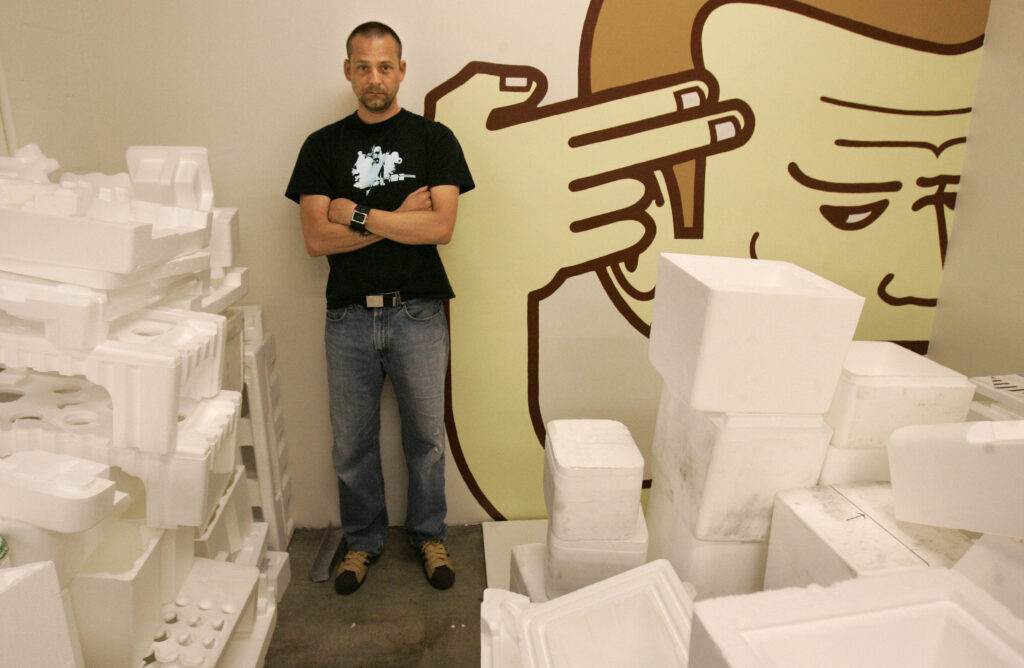Styrofoam to Styrobots

Walking through a darkened corridor of Lawrence Hall on the University of Oregon campus, something against the wall catches the eyes of the self-described “obsessive observer.” Something small and dusty and – like a lot of things Michael Salter finds – just another of society’s discarded items: A severed wheel from a chair or desk or something that might just end up in his art someday.
He scoops it up in midstride.
“I thought it was kind of interesting,” Salter says later at his studio. “Things have a way of kind of hanging out in here. And then sometimes they move on, sometimes they just sit around.”
Sit around like all that expanded polystyrene – commonly known as Styrofoam – in the corner of his Lawrence Hall studio.
There’s contemporary art and there’s temporary art and there’s Michael Salter’s art which, more often than not, is both.
An associate professor of digital arts at the UO since 2005, Salter has created somewhat of a stir in the art world with his “Styrobots,” robots made of Styrofoam that have appeared in galleries from the Bay Area to Brussels and are anywhere from 16 inches to an enormous 22 feet tall. That latter one has been on display at the San Jose Art Museum in California since April, part of the museum’s “Robots: Evolution of a Cultural Icon” exhibit that runs through Oct. 19.
Sadly, though, Salter’s unique creations are usually destroyed because no one has bought one yet – or figured out how to get one through a gallery door even if they wanted to make a purchase.
“They are smashed to smithereens, which some people say is pretty fun,” Saltersays. But he’s not in this for the money, he’s a true artist to the core – more interested in making a statement than a buck.
“I have sort of this love-hate relationship with popular culture or consumerism in general,” says Salter, 41, who grew up in Connecticut making robots with Legos like lots of American children.
“I have a sneaker collection,” he admits, “which is absurd, right? You don’t need more than one pair of sneakers. But at the same time, I’m conscious of the fact that this culture is about collecting stuff. The fact that we buy electronics at a time when they’re no longer really repairable … I mean, I know there’s a TV-repair shop somewhere, but I’ve never gone to a TV-repair shop in my life. You drag it to the curb and then you buy a new one. And the foam takes up more space in the box than the object does.”
Salter began working with Styrofoam about five years ago in North Carolina, where he taught at Mount Olive College.
“I looked at a piece like this,” he says, grabbing a typical chunk in his pile that looks like it once slid neatly onto the side of a stereo or DVR, “and to me it looks just incredibly mechanical. It sounds silly, but it was really just a matter of cutting them up a few times and sticking them together.”
His first “big one” was 6 feet tall. That led to his first solo show at the Southeastern Center for Contemporary Art in Winston-Salem, N.C. It was for that space that former curator David Brown suggested to Salter: “Why don’t you make a really big one?”
With a 30-foot space available to him there, “I went to town,” Salter says.
Don’t think it’s something you can figure out overnight, though. Salter spent all winter creating his largest Styrobot yet at the former Romania Chevrolet dealership in east Eugene, a building now owned by the UO. With only a 15-foot-high ceiling, he made the arms, legs and torso separately. Then he had two friends drive all the pieces in a rental movingvanto San Jose, where Salter and seven others assembled it at the museum, using a hydraulic lift, among other things.
“And I never saw it put together until it was in the museum,” Salter says. “So the curator’s kind of nervous, I’m kind of nervous, and everybody’s wondering if it’s going to stand up, and they’ve invested some money in me and I’ve spent all winter building it …?”
And?
“It stood up,” Salter says. “And it’s still standing up.” The structure, held together by a wooden armature, could easily be knocked down “if you got a running start,” he says. Therefore, several smaller Styrobots “stand guard” as part of the exhibit to keep viewers from getting too close.
It only took about two hours to assemble the robot with Gorilla Glue, which is somewhat ironic since Salter wanted this one “to be sort of gorillalike, knuckles dragging or almost dragging.”
And the response? “It was very flattering,” Salter says of opening night. “It was great. I think it’s like the centerpiece of the show, really. It’s just enormous. You walk in a pretty standard-size door … and you look up and this thing’s like 80 yards away and it still looks huge.
“The funny thing is, I built the whole thing by buying glue over at Hirons and tape at Market of Choice. It probably cost me $120 to make.” And how much would it sell for? That would not be appropriate to say, Salter says.
The 14-foot one at the Jeff Bailey Gallerythat was part of his solo show – scheduled to be reviewed in an upcoming issue of “Art in America” magazine – in New York City in January and February was listed at $18,000.
“It more or less dominated the space,” Bailey says. “People were quite taken by the show and its use of materials. There’s this very much of a hand-crafted element to what he makes, but there’s also this mass-marketing quality.”
Brown, now the deputy director of art at the Art Museum of West Virginia, writes that “the Styrobots are dazzling in their splendor, ambitious in their realization, and serve evidence to the artist’s expansive interest in the bombardment of images that we suffer.”
But how does Salter find all that Styrofoam floating around?
“Most people give it to me,” he says.
Salter put the word out at UO by press release and also advertised his need online.
“Every day when I come to work, there’s some outside the door. I used to Dumpster dive all the time. Occasionally, I’ll get a call from the library saying, `We just bought 50 computers. You might want to get over here.’?” He also obtained much of the stuff at NextStep Recycling in Eugene.
“I have a long history of using whatever is around,” Salter says. “And it can be confused with being sort of the champion recycling guy – and I’m not. I just use what’s around. And I think that’s actually a better idea of sustainability in the end.”
ON THE WEB
To see and hear more on Michael Salter, his Styrobots and other creations. Visit his Web site at www.michaelasalter.com.
First place award for best personality feature story in the 2009 Oregon Newspaper Publishers Association “Better Newspaper Contest.”

Mark Baker has been a journalist for the past 25 years. He’s currently the sports editor at The Jackson Hole News & Guide in Jackson, Wyo.
